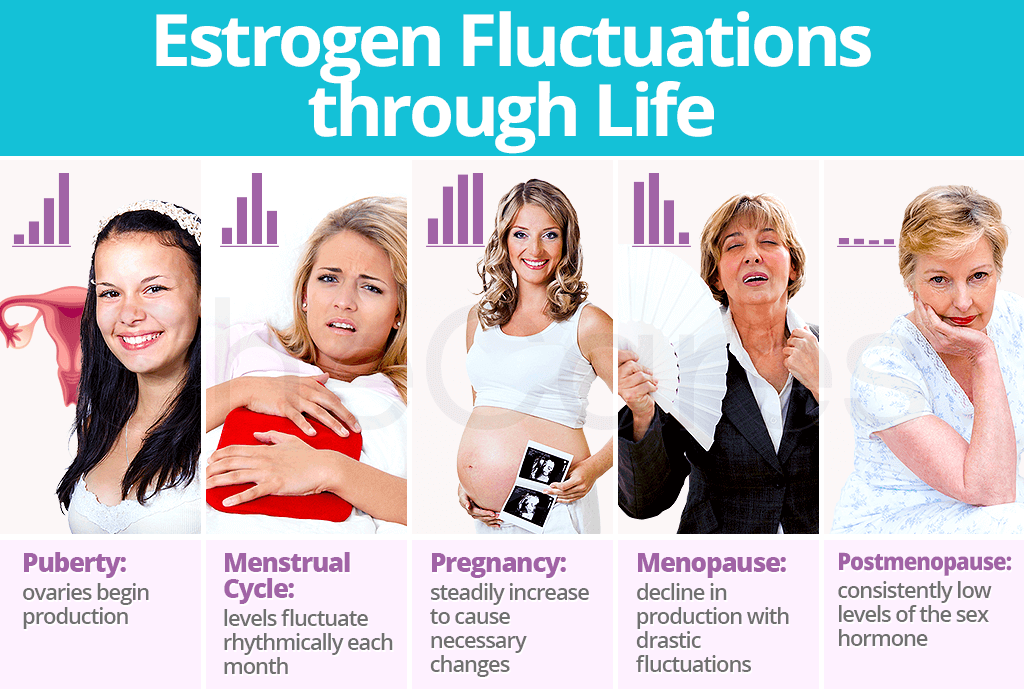As previously mentioned, the stage of reproductive life a woman is in will greatly influence which estrogen hormones she produces and to what quantity. Estrogen production and secretion is regulated by specific glands, organs, and body systems.
Because estrogens have an instrumental role in women's overall health, it is important to understand the hormone's natural fluctuations through life.
Estrogen during Puberty
A series of events initiated by the hypothalamus stimulates the ovaries to begin estrogen production. Consequently, augmented production of sex hormones causes the first menstrual period - known as menarche - as well as breast and genital growth, weight distribution, body hair, and more bodily changes.
In general, the pattern of menstrual cycles should begin to normalize within the first few years of menstruation. However, identifying abnormalities during adolescence may prevent the future development of serious health concerns.
Estrogen during the Menstrual Cycle
Estrogen levels naturally rise and fall throughout each menstrual cycle. The hormone is principally responsible for growing the endometrium during the follicular phase. Then, a peak in levels triggers ovulation, after which progesterone levels rise above those of estrogen in the luteal phase.
There may be times when estrogen levels deviate from normal due to environmental factors, stress, health issues, and more. Proper vigilance will prevent the onset of a more serious health condition.
Estrogen and Pregnancy
Estrogen is one of the most important hormones needed to make conception possible for a woman. Before ovulation, the hormone is responsible for growing and maturing the uterine lining in preparation for nourishing an embryo. Then, after conception, estrogen continues causing pregnancy-related changes until parturition.
Find out more about estrogen and pregnancy, including the hormone's paramount involvement during gestation and post-partum when nurturing a newborn.
Estrogen and Menopause
Menopause is a point in time in which a woman has gone 12 consecutive months without a period. The period of time before this date - usually 8 to 10 years- is known as perimenopause; however, most refer to perimenopause as, simply, menopause.
By the time a woman reaches her 40s, the number and quality of her follicles diminishes, causing a decline in estrogen production. Also, women do not produce as much progesterone to counteract the effects of estrogen.
Learn more about estrogen and menopause as well as how these hormonal fluctuations during the menopausal transition can evoke a variety of bothersome symptoms.
Estrogen and Postmenopause
Postmenopause is the time after menopause has been declared. From this date onward, women generally do not ovulate nor menstruate, and levels of primary sex hormones reach consistently lower or higher levels, causing more severe symptoms and sometimes life-threatening conditions. Find out more information about estrogen and postmenopause, including its far-reaching effects in the female body at this time.
Sources
- The American College of Obstetricians and Gynecologists. (2015). Menstruation in Girls and Adolescents: Using the Menstrual Cycle as a Vital Sign. Retrieved July 14, 2017, from https://www.acog.org/Resources-And-Publications/Committee-Opinions/Committee-on-Adolescent-Health-Care/Menstruation-in-Girls-and-Adolescents-Using-the-Menstrual-Cycle-as-a-Vital-Sign
- Briden, L. (2015). Period Repair Manual: Natural Treatments for Better Hormones and Better Periods. Publisher: Author.
- Conrad, C. (2005). A Woman's Guide to Natural Hormones. New York: Penguin Group. Available from Google Books.
- Delemarre, E.M. et al. (2008). Inducing puberty. European Journal of Endocrinology, 159, S9-S15. doi: 10.1530/EJE-08-0314
- Harvard Health Publications. (2017). Perimenopause: Rocky road to menopause. Retrieved July 14, 2017, from http://www.health.harvard.edu/womens-health/perimenopause-rocky-road-to-menopause
- NHS. (2015). Girls and puberty Q&A. Retrieved July 14, 2017, from http://www.nhs.uk/Livewell/Sexandyoungpeople/Pages/Girlspuberty.aspx
- Wershler, L. (2015). Why young teens need real periods – not the Pill. Retrieved July 14, 2017, from http://www.menstruationresearch.org/2015/09/08/why-young-teens-need-real-periods-not-the-pill/
